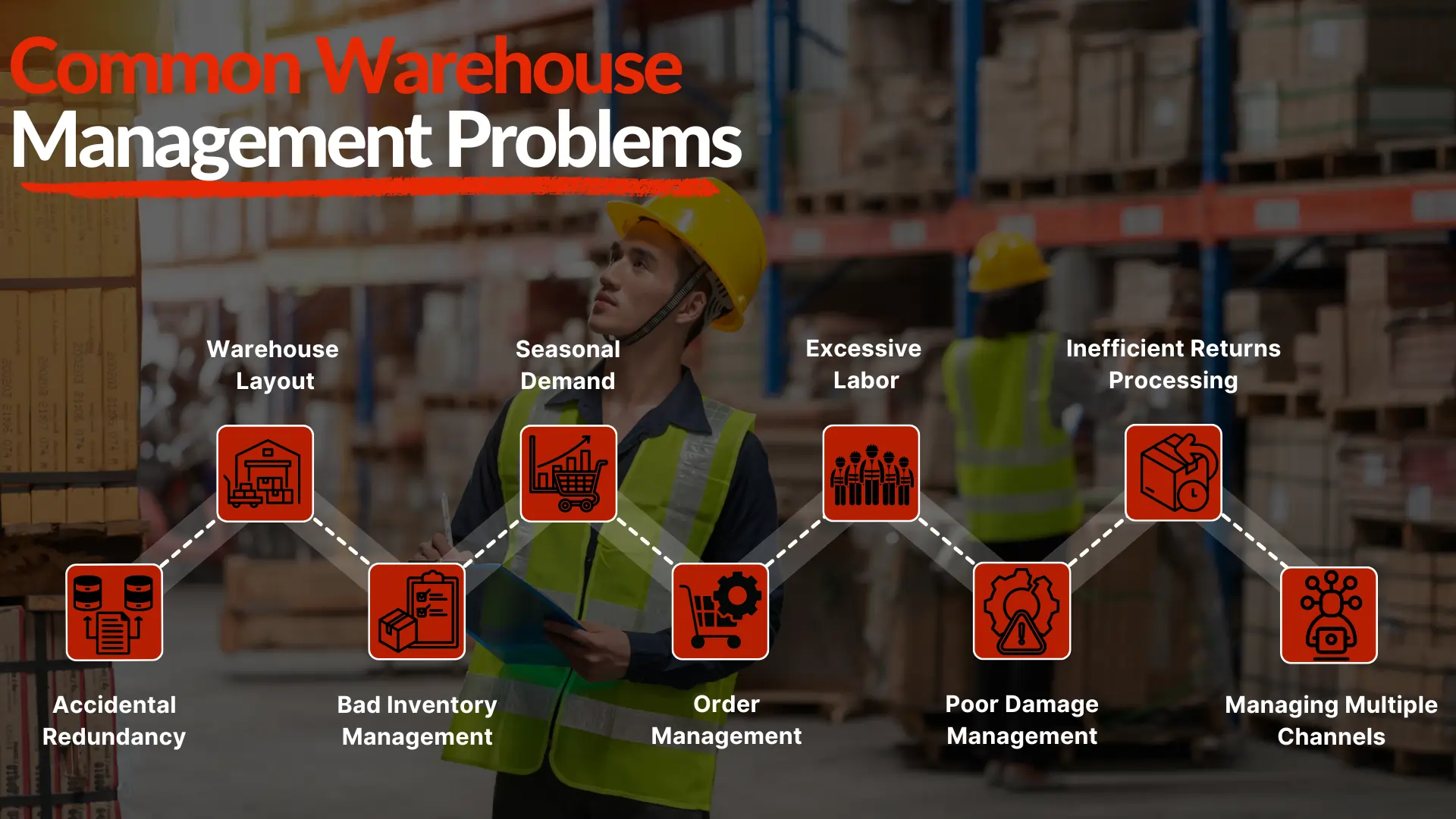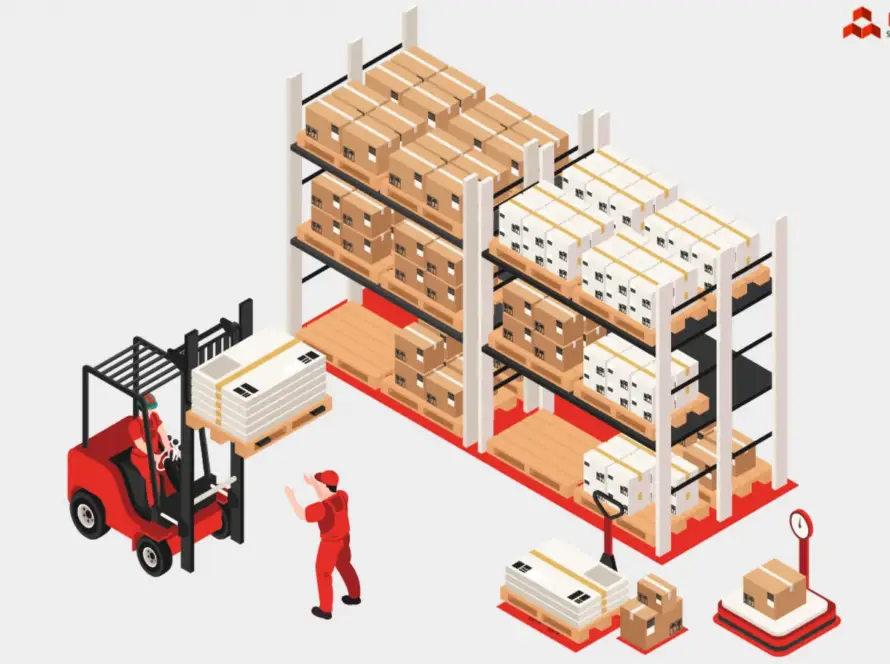Warehouse Management Problems
Warehouse management entails arranging, managing, and maintaining all of the operations that take place in a warehouse so that they operate as smoothly and efficiently as possible. Even though some of these operations appear to be automated and error-free, every warehouse operation is prone to faults and obstacles. Warehouse issues can have an impact on the speed, efficiency, and productivity of a single warehouse operation or an entire chain of related procedures.
Most of the time, these problems are discovered after the procedure has begun, if not already completed. And by that point, it’s frequently too late to prevent the error—or even to mitigate the damage. However, if you are aware of the various issues that may arise in your warehouse operation, you may plan ahead of time and prevent damage from occurring.
In this post, we’ll look at some of the most typical warehouse management system issues, and how to avoid them.

Accidental Redundancy
Most warehouses conduct many activities on each item, which are linked together to form workflows. However, if a workflow is not well-organized, the identical process may be executed more than once by accident. These redundancies raise your labor costs and require extra time when you have to go back and correct the error.
This occurs more frequently in large warehouses than in smaller ones, as there is more room and merchandise to deal with. Redundancy is frequently observed in order picking, which occurs when products are selected from their storage locations in a warehouse to fulfill an order. In smaller facilities, order picking is a one-person process with a limited margin for error.
Compared to that, in a larger warehouse, numerous individuals collaborate to pick products from various areas of the warehouse in order to fulfill a single request. Because the same order is handed around to numerous people, there is a higher potential of errors, such as selecting too many of the same products.
Solution:
Investing in technology, such as a modern warehouse execution system (WES), can help you automate redundancy-prone activities in your warehouse. For example, to decrease redundancy in order picking, you could utilize barcode technology to scan the products selected for the order and have the system notify the user of any duplicates.
A Must Read: Indian Warehousing Market Report
Warehouse Layout
Rising storage costs have prompted warehouse managers to make better use of their space over time. However, a survey done in 2018 found that it does not always work—manufacturers only used about 68% of their storage capacity. Inadequate storage due to inefficient space utilization is a widespread issue in warehouses.
Solution:
Creating an optimal warehouse plan helps overcome this issue. This includes maximizing floor and vertical space while yet allowing warehouse staff to walk through. It also entails investigating ways to employ technology and equipment to save labor and labor expenses, enhancing product accessibility in the warehouse, categorizing inventory in a systematized way, and ensuring that inventory is stored safely.
Bad Inventory Management
Expecting a product to be in one area but finding it elsewhere, taking orders assuming you have adequate stock only to discover you don’t, or canceling requests presuming stock is unavailable when it is actually available are all signs of erroneous inventory records. Mismanagement of this nature might result in delayed backorders, longer lead times, and difficulty with restocking.
Solution:
One method to tackle these warehouse difficulties is to upgrade to a newer solution. This could be a system dedicated to inventory management or a general warehouse management software package that includes real-time inventory management capabilities. A typical system first collects inventory data via a handheld or fixed device, such as a barcode scanner. This data is then routed to your software solution, which catalogs and tracks your inventory.
Seasonal Demand
Some products have consistent demand throughout the year, while others have seasonal increases. Sudden demand surges might pose problems if your warehouse is not prepared, either owing to a shortage of inventory or a lack of storage capacity. Being taken off guard by such differences can result in lost opportunities and inefficiencies. To avoid this, stay current on market trends and predict changes in demand for your items. This allows you to better control stock levels and guarantee that your warehouse is capable of handling variable order quantities.
Solution:
Maintaining communication with your manufacturers, distributors, retailers, and transporters is critical for coordinating all aspects of the supply chain. This shared knowledge enables everyone to respond efficiently to demand variations. Using demand forecasting tools can help you improve your preparation by allowing you to store the proper supplies for each season.
Organize your warehouse to emphasize seasonal products, placing them in easily accessible locations to speed up order fulfillment. Additionally, invest in equipment and automation technologies such as pallet flow rack systems, forklift trucks, and AS/RS to increase efficiency and speed up warehouse operations.
You May Also Like to Read: Core Components of Warehouse Management System
Order Management
Order management is one of the most crucial tasks in a warehouse, but it also has the highest number of reported faults. Order management includes all of the operations that begin the moment an order is received, from accepting the order to picking, packing, and shipping the correct products to the correct consumer, as well as handling post-sales activities such as refunds and returns as needed.
A mistake in any of these stages can cause the entire workflow to collapse, necessitating the redoing of all phases from the beginning. This is certainly a waste of time and money, and your customer will receive their order later than intended.
Solution:
Many companies choose an order management system (OMS) to ensure efficient order processing. An order management system (OMS) accelerates order fulfillment by managing shipping, customer notifications, and inventory management, depending on the solution. It enables organizations to manage their whole order cycle more efficiently, eliminating errors and increasing customer happiness.
Excessive Labor
General cleaning, forklift operation, material handling, shipping and receiving, product picking, and overall management are all examples of manual labor-intensive warehouse operations. While many warehouses are investing in technology and automation to optimize processes, there is a widespread belief that only technology is expensive.
In actuality, manual work can be very expensive labor accounts for 50-70% of a warehouse’s budget, making it one of the most significant operating costs. Thus, establishing a balance between technology and labor efficiency is critical for cost reduction.
Solution:
Begin by reviewing all forms of labor duties performed in your warehouse. Then, review your present solutions and processes to see if you can automate any further tasks. Small firms frequently choose to consolidate their warehouses with a partner to save space and redirect the savings toward automating more processes. This strategy greatly lowers labor expenses while increasing overall efficiency. Businesses can establish a more streamlined and cost-effective warehouse environment by making the best use of existing systems and thinking about consolidation.
Poor Damage Management
Poor damage management in warehouses can result in considerable losses, reduced inventory integrity, and dissatisfied customers. When products are damaged during storage or handling, it raises operational expenses, causes order fulfillment delays, and may tarnish the company’s reputation. Addressing these issues is critical to sustaining an efficient warehouse operation.
Solution:
Invest in appropriate shelving and storage solutions to reduce the chance of accidents. Implement staff training programs on safe handling methods to limit the risk of damage during loading, unloading, and storage. Use proper packaging materials and protective measures for fragile objects. Inspect the warehouse for risks on a regular basis and conduct audits to discover improvement opportunities. Warehouses that prioritize damage control may protect their inventory, increase operational efficiency, and maintain customer happiness.
Inefficient Returns Processing
Efficiently processing returned items is a significant challenge for warehouses. The return procedure frequently includes additional steps like as inspection, repackaging, and restocking. When returns are not processed quickly, it can lead to inventory imbalances, decreased product availability, and, eventually, disgruntled customers. In today’s fast-paced market, addressing these issues is critical to preserving operational efficiency and customer happiness.
Solution:
To streamline returns processing, warehouses could set up a structured returns management system that allows for speedy examination and classification of returned items. Designating a dedicated space for processing returns might assist organize and speed up the process. Investing in staff training for efficient returns handling can also save processing time.
Managing Multiple Channels
Managing inventory across numerous sales channels, such as online platforms, traditional shops, and third-party marketplaces, poses distinct issues for warehouses. This level of complexity can make inventory tracking, order fulfillment, and returns management more difficult, especially when each channel has unique requirements and consumer expectations.
A warehouse, for example, may be at risk of overselling a product online if inventory levels are not updated as soon as products are sold in physical locations. This circumstance might result in client unhappiness, higher return rates, and lost sales opportunities.
Solution:
To address these difficulties efficiently, warehouses should create a consolidated inventory management system that provides real-time visibility across all sales channels. This assures proper inventory tracking and avoids errors, which could lead to overselling. Regularly syncing inventory data across all channels is critical for maintaining accurate stock levels and avoiding stockouts.
Warehouses that implement these tactics can improve operational efficiency, increase customer happiness, and successfully manage inventory across several sales channels.

Conclusion
Capable warehouse management is critical for ensuring smooth operations and achieving customer expectations. Warehouses can improve productivity and efficiency by addressing typical concerns such unintended redundancy, poor inventory management, and wasteful return processing. Implementing technology, improving layouts, and utilizing centralized inventory systems are all effective solutions for overcoming these issues.
Furthermore, maintaining good communication throughout the supply chain and being up to date on market trends can help warehouses better manage seasonal demand and numerous sales channels. By focusing on these solutions, warehouses can enhance overall performance, lower costs, and provide a better customer experience.
Thanks For Reading: Common Warehouse Management Problems
Powered By 360Presence

